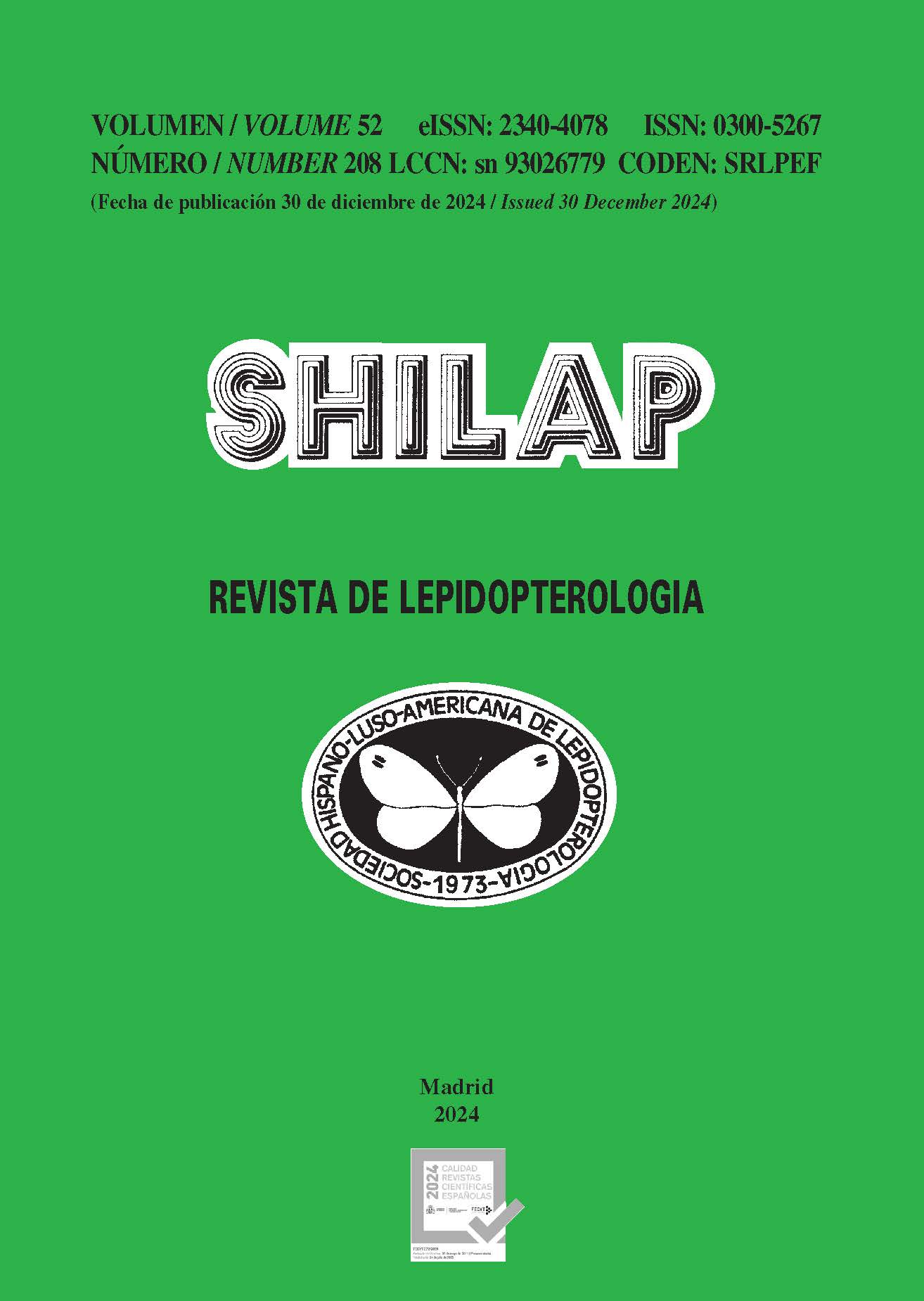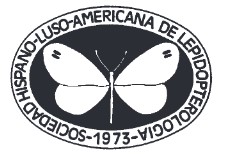Imma phuocbuu Buchsbaum, Chi & Chen, sp. nov. from south Vietnam (Lepidoptera: Immidae)
DOI:
https://doi.org/10.57065/shilap.1016Keywords:
Lepidoptera, Immidae, Imma phuocbuu, new species, distribution, biotope, taxonomy, VietnamAbstract
During a faunal survey of Lepidoptera in 2023, Imma phuocbuu Buchsbaum, Chi & Chen, sp. nov. was discovered and represents the first record of the genus in Vietnam. A single male specimen was collected from a transitional biotype between mangrove and semi-deciduous dry lowland forest habitats near the coast. The new species is distinguished from Imma transversella (Snellen, 1878), I. semicitra Meyrick, 1937 and I. semiclara Meyrick, 1929 by differences in wing pattern and genitalia morphology.
Downloads
Global Statistics ℹ️
|
675
Views
|
145
Downloads
|
|
820
Total
|
|
References
Averyanov, L. V., Loc, PO. K., Hiep, N. T., & Harder, D. K. (2003). Phytogeographyc review of Vietnam and adjected areas of Eastern Indochina. Komarovia, 3, 1-83.
Brooks, T (2010). Conservation planning and priorities, Chapter 11. In N. S. Sodhi & P. R. Ehrlich (eds.). Conservation Biology for All, Oxford, 2010, 199-219. https://doi.org/10.1093/acprof:oso/9780199554232.003.0012 DOI: https://doi.org/10.1093/acprof:oso/9780199554232.003.0012
Brooks, T. M., Mittermeier, R. A., Mittermeier, C. G., da Fonseca, G. A. B., Rylands, A. B., Konstant, W. R., Flick, P., Pilgrim, J., Oldfield, S., Magin, G., & Hilton-Taylors, C. (2002). Habitat Loss and Extinction in the Hotspots of Biodiversity. Conservation Biology, 16(4), 909-923. https://doi.org/10.1046/j.1523-1739.2002.00530.x DOI: https://doi.org/10.1046/j.1523-1739.2002.00530.x
Buchsbaum, U., Grehan, J. R., Chen, M.-Y., Chi, N. M., Pham, D. L., Khai, T. Q., Jones, L. D., & Ignatev, N. (2022). New species of Endoclita C. and R. Felder, 1874 and first record of. E. salvazi from Vietnam (Insecta: Lepidoptera: Hepialidae). Vernate, 41, 267-286.
Buchsbaum, U. (2019). A new species of the genus Ceneressa Obraztsov, 1957 from northern Thailand (Lepidoptera, Erebidae, Arctiinae, Syntomini). Nachrichten des entomologischen Vereins Apollo, N. F., 40(1), 62-64.
Buchsbaum, U., Brüggemeier, F., & Chen, M.-Y. (2014). A new species of the genus Callidrepana Felder, 1861 from Laos (Lepidoptera, Drepanidae). Entomofauna, Supplement, 17, 45-53.
Callighan, C. J. (2009). The Riodinid Butterflies of Vietnam (Lepidoptera). Journal of the Lepidopterologists’ Society, 63(2), 61-82.
Cerny, K., & Pinratana, B. A. (2007). Arctiidae. Moths of Thailand (Vol. 6). Brothers of Saint Gabriel.
Clarke, J. F. G. (1986). Pyralidae and Microlepidoptera of the Marquesas Archipelago. Smithsonian Contributions to Zoology, Washington, 416. https://doi.org/10.5479/si.00810282.416 DOI: https://doi.org/10.5479/si.00810282.416
De Lattin, G. (1967). Grundriss der Zoogeographie. VEB Gustav Fischen Verlag Jena.
Diakonoff, A. (1986). Glyphipterygidae auctorum sensu lato (Glyphipterygidae sensu Meyrick, 1913); Tortricidae: Hilarographini, Choreutidae, Brachodidae (partim), Immidae and Glyphipterygidae. Microlepidoptera Palaearctica (Vol. 7). G. Braun.
Dugdale, J.S., Kristensen, N.P., Robinson, G.S. & Scoble. M.J. (1999) The smaller Microlepidoptera-Grade Superfamiles. In: Kristensen, N.P. (ed.), Handbook of Zoology, volume 4, Arthropoda: Insecta, part 35. Lepidoptera, moths and butterflies, volume 1: Evolution, Systematics, and Biogeography. Walter de Gruyter. DOI: https://doi.org/10.1515/9783110804744.217
Fa, J. E., & Funk, S. M. (2007). Global endemicity centres for terrestrial vertrebrates: an ecoregions approach. Endangered Species Research, 3, 31-52. https://doi.org/10.3354/esr003031 DOI: https://doi.org/10.3354/esr003031
Heppner, J. B. (1977). The status of the Glyphipterigidae and a reassessment of relationships in Yponomeutoid families and ditrysian superfamilies. Journal of the Lepidopterists’ Society, 31, 124-134.
Heppner, J. B. (1982a). Review of the family Immidae, with a world checklist (Lepidoptera: Immoidea). Entomography, 1, 257-279.
Heppner, J. B. (1982b). Synopsis of the Glyphipterigidae (Lepidoptera: Copromorphoidea) of the world. Proceedings of the Entomological Society of Washington, 84, 38-66.
Heppner, J. B. (1991). Faunal Regions and the Diversity of Lepidoptera. Tropical Lepidoptera, 2(Suppl. 1), 1-85.
Holloway, J. D., Kibby, G., & D. Peggie (2001). The Families of Malesian moths and butterflies. Brill. https://doi.org/10.1163/9789004475595 DOI: https://doi.org/10.1163/9789004475595
Kier, G., Kraft, H., Lee, T. M., Jetz, W., Ibisch, P. L., Nowicki, C., Mutke, J., & Barthlott, W. (2009). A global assessment of endemism and species richness across island and mainland regions. PNAS, 106(23), 9322-9327. https://doi.org/10.1073/pnas.0810306106 PMid:19470638 PMCid:PMC2685248 DOI: https://doi.org/10.1073/pnas.0810306106
Küppers, P. V., & Buchsbaum, U. (2015). Phacusa janikornae sp. n. from South Thailand (Lepidoptera, Zygaenidae, Procridinae) with description of the biology. Nachrichten des entomologischen Vereins Apollo, N. F., 36(2/3), 148-152.
Manh, V. Q. (2015). Zoogeographical division of Vietnam based on the Oribatid Mite (Acari: Oribatida) Fauna. Tap Chi Sinh Hoc, 37(3), 353-361. https://doi.org/10.15625/0866-7160/v37n3.7592 DOI: https://doi.org/10.15625/0866-7160/v37n3.7592
Marchese, C. (2015). Biodiversity hotspots: A shortcut for more complicated concept. Global Ecology and Conservation, 3, 297-309. https://doi.org/10.1016/j.gecco.2014.12.008 DOI: https://doi.org/10.1016/j.gecco.2014.12.008
Ministery of Natural Resources and Environment (MONRE) (2020). Vietnam National Biodiversity Strategy to 2020, Vision to 2030. Hanoi.
Mittermeier, R. A., Turner, W. R., Larsen, F. W., Brooks, T. M., & Gascon, C. (2011). Global Biodiversity Conservation: the Critical Role of Hotspots, Chapter 1. In F. E. Zachos & J. C. Habel (eds.). Biodiversity Hotspots. https://doi.org/10.1007/978-3-642-20992-5_1 DOI: https://doi.org/10.1007/978-3-642-20992-5_1
Mittermeier, R. A., Myers, N., Thomsen, J. B., da Fonseca, G. A. B., & Olivieri, S. (1998). Biodiversity Hotspots and Major Tropical Wilderness Areas: Approaches to Setting Conservation Priorities. Conservation Biology, 12(3), 516-520. https://doi.org/10.1046/j.1523-1739.1998.012003516.x DOI: https://doi.org/10.1046/j.1523-1739.1998.012003516.x
Myers, N., Mittermeier, R. A., Mittermeier, C. G., da Fonseca, G. A. B., & Kent, J. (2000): Biodiversity hotspots for conservation priorities. Nature, 403, 853-858. https://doi.org/10.1038/35002501 PMid:10706275 DOI: https://doi.org/10.1038/35002501
Olson, D. M., & Dinerstein, E., (2002). The Global 200: Priority Ecoregions for Global Conservation. Annals of the Missouri Botanical Garden, 89(2), 199-224. https://doi.org/10.2307/3298564 DOI: https://doi.org/10.2307/3298564
Phuong, V. T., & Lin, T. M. (2011). Final report on Forest Ecological Stratification in Vietnam. UN-REDD Programme Vietnam.
Robinson, G. S. (1976). The preparation of slides of Lepidoptera genitalia with special reference to the Microlepidoptera. Entomologist’s Gazette, 27, 127-132.
Robinson, G. S., Tuck, K. R., & Shaffer, M. (1994). A Field Guide to the smaller moths of South-East Asia. Malaysian Nature Society.
Schintlemeister, A. (1997a). Moths of Vietnam with special reference to Mt. Fan-si-pan. Introduction and collection localities. Entomofauna, Supplement, 9(1), 1-12.
Schintlemeister, A. (1997b). Moths of Vietnam with special reference to Mt. Fan-si-pan. Family Notodontidae. Entomofauna, Supplement, 9(4), 33-248.
Schintlmeister, A. (2001). Zoogeographie vietnamesischer Heterocera unter besonderer Berücksichtigung der Zahnspinner (Lepidoptera: Notodontidae). Phyllodrom-Journal. Abhandlungen und Berichte aus der Regenwaldforschung. Tagungsberichte / Phyllodrom-Journal. Abhandlungen und Berichte aus der Regenwaldforschung. Tagungsberichte (Vol. 1, pp. 89-90).
Schintlmeister, A. (2003). The zoogeography of Taiwans’s Notodontidae (Lepidoptera). Journal of the Zoological Society Wallacea, 1, 15-26.
Schintlmeister, A., & Pinratana, B. A. (2007). Moths of Thailand. Notodontidae (Vol. 5). Brothers of Saint Gabriel. https://doi.org/10.1163/9789004260993 DOI: https://doi.org/10.1163/9789004260993
Sechrest, W., Brooks, T. M., de Fonseca, G. A. B., Konstant, W. R., Mittermeier, R. A., Purvis, A., Rylands, A. B., & Gittleman, J. L. (2002). Hotsspots and the conservation of evolutionary history. PNAS, 99(4), 2067-2071. https://doi.org/10.1073/pnas.251680798 PMid:11854502 PMCid:PMC122320 DOI: https://doi.org/10.1073/pnas.251680798
Smith, J. R., Hendershot, J. N., Nova, N., & Daily G. C. (2020). The biogeography of ecoregions: Descriptive power across the regions and taxa. Journal of Biogeography, 47(7), 1413-1426. https://doi.org/10.1111/jbi.13871 DOI: https://doi.org/10.1111/jbi.13871
Sodhi, N. S., Koh, L.-P., Brook, B. W., & Ng, P. K. L. (2004). Southeast Asian biodiversity: an impending disaster. TRENDS in Ecology and Evolution, 19(12), 654-660. https://doi.org/10.1016/j.tree.2004.09.006 PMid:16701328 DOI: https://doi.org/10.1016/j.tree.2004.09.006
Turner, H., Hovenkamp, P., & van Welzen, P. C. (2001). Biogeography of Southeast Asia and the West Pacific. Journal of Biogeography, 28, 217-230. https://doi.org/10.1046/j.1365-2699.2001.00526.x DOI: https://doi.org/10.1046/j.1365-2699.2001.00526.x
Wondroff, D. S. (2010). Biogeography and conservation in Southeast Asia: shows 2.7 million years of repeated environmental fluctuations affect today’s patterns and the future of the remaining refugial-phase biodiversity. Biodiversity Conservation, 19(4), 919-941. https://doi.org/10.1007/s10531-010-9783-3 DOI: https://doi.org/10.1007/s10531-010-9783-3
Vu, L. V. & Vu, C. Q. (2011), Diversity pattern of Butterfly communities (Lepidoptera, Papilionoidea) in different habitat types in a tropical rain forest of southern Vietnam. DOI: https://doi.org/10.5402/2011/818545
Published
How to Cite
Issue
Section
License
Copyright (c) 2024 Ulf Buchsbaum, Mei-Yu Chen, Nguyen Minh Chi

This work is licensed under a Creative Commons Attribution 4.0 International License.
The author SS retains his trademark and patent rights to any process or procedure within the article.
The author retains the right to share, distribute, perform and publicly communicate the article published in SHILAP Revista de lepidopterología, with initial acknowledgement of its publication in SHILAP Revista de lepidopterología.
The author retains the right to make a subsequent publication of his work, from using the article to publishing it in a book, provided that he indicates its initial publication in SHILAP Revista de lepidopterología.
Each submission to SHILAP Revista de lepidopterología must be accompanied by an acceptance of copyright and acknowledgement of authorship. By accepting them, authors retain copyright of their work and agree that the article, if accepted for publication by SHILAP Revista de lepidopterología, will be licensed for use and distribution under a "Creative Commons Attribution 4.0 International" (CC BY 4.0) licence that allows third parties to share and adapt the content for any purpose giving appropriate credit to the original work.
You may read here the basic information and the legal text of the license. The indication of the CC BY 4.0 License must be expressly stated in this way when necessary.
As of 2022, the content of the print and digital version is licensed under a "Creative Commons Attribution 4.0 International License" (CC BY 4.0), licence that allows third parties to share and adapt the content for any purpose giving appropriate credit to the original work.
Previous content in the journal was published under a traditional copyright licence; however, the archive is available for free access.
When using the contents of SHILAP Revista de lepidopterología published before 2022, including figures, tables or any other material in printed or electronic format belong to the authors of the articles, the authors must obtain the permission of the copyright holder. Legal, financial and criminal liabilities in this respect belong to the author(s).
In application of the Principle of Priority of the International Code of Zoological Nomenclature, no other version than the one published by the publisher may be deposited in repositories, personal websites or similar.





























